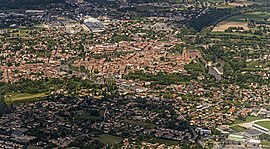world.wikisort.org - France
Lavaur (French pronunciation: [lavɔʁ]; Occitan: La Vaur) is a commune in the Tarn department in southern France.
Lavaur | |
|---|---|
Commune | |
 An aerial view of Lavaur | |
 Coat of arms | |
Location of Lavaur  | |
 Lavaur  Lavaur | |
| Coordinates: 43°41′59″N 1°49′11″E | |
| Country | France |
| Region | Occitania |
| Department | Tarn |
| Arrondissement | Castres |
| Canton | Lavaur Cocagne |
| Intercommunality | CC Tarn-Agout |
| Government | |
| • Mayor (2020–2026) | Bernard Carayon[1] |
| Area 1 | 62.83 km2 (24.26 sq mi) |
| Population | 10,879 |
| • Density | 170/km2 (450/sq mi) |
| Time zone | UTC+01:00 (CET) |
| • Summer (DST) | UTC+02:00 (CEST) |
| INSEE/Postal code | 81140 /81500 |
| Elevation | 105–274 m (344–899 ft) (avg. 141 m or 463 ft) |
| 1 French Land Register data, which excludes lakes, ponds, glaciers > 1 km2 (0.386 sq mi or 247 acres) and river estuaries. | |
History
Lavaur was taken in 1211 by Simon de Montfort during the wars of the Albigenses, a monument marking the site where Dame Giraude de Laurac (Lady of Lavaur) was killed,[3] being thrown down a well and stoned to death.[4] The town was also taken several times during the religious wars of the 16th century.
Geography
Lavaur stands on the left bank of the Agout, which is here crossed by a railway-bridge and a fine stone bridge of the 1770s.[5] It lies 36 km southwest of Albi and 32 km east of Toulouse.
Demographics
| Year | Pop. | ±% p.a. |
|---|---|---|
| 1968 | 7,665 | — |
| 1975 | 7,897 | +0.43% |
| 1982 | 7,972 | +0.14% |
| 1990 | 8,148 | +0.27% |
| 1999 | 8,537 | +0.52% |
| 2007 | 10,036 | +2.04% |
| 2012 | 10,242 | +0.41% |
| 2017 | 10,811 | +1.09% |
| Source: INSEE[6] | ||
Sights

From 1317 till the French Revolution Lavaur was the seat of a bishopric; Lavaur Cathedral, dedicated to Saint Alan, was built for this purpose, dating from the 13th, 14th and 15th centuries, with an octagonal bell-tower. A second, smaller square tower contains a jaquemart (a statue which strikes the hours with a hammer) of the 16th century. In the bishops garden is the statue of Emmanuel, comte de Las Cases, one of the companions of Napoleon at Saint Helena.
Economy
The town carries on distilling and flour-milling and the manufacture of brushes, plaster and wooden shoes.
Notable residents
- Pierre Fabre, founder of Laboratoires Pierre Fabre[7]
- Étienne de Voisins-Lavernière (1813–1898), French deputy and then senator for Tarn
Miscellaneous
There is a subprefecture and a tribunal of first instance (a lower Court of Justice).
See also
References
- "Répertoire national des élus: les maires". data.gouv.fr, Plateforme ouverte des données publiques françaises (in French). 2 December 2020.
- "Populations légales 2019". The National Institute of Statistics and Economic Studies. 29 December 2021.
- "The Local Area around ourTarn Gite close to: Lavaur, Toulouse, Castres, Albi, Gaillac, Nalanda Buddhist Monastery, Vajrayogini Buddhist Institute, Cordes-sur-Ciel". Archived from the original on 2010-03-01. Retrieved 2010-04-30.
- "Languedoc (Traditional province, France)". www.crwflags.com. Retrieved 13 April 2018.
- Base Mérimée: Pont Saint-Roch, Ministère français de la Culture. (in French)
- Population en historique depuis 1968, INSEE
- "Pierre Fabre, founder of pharmaceutical giant, dies". Agence France Presse. France 24. 2013-07-20. Archived from the original on 2013-07-23. Retrieved 2013-08-17.
На других языках
[de] Lavaur (Tarn)
Lavaur (lateinisch Pulchravallis; okzitanisch La Vaur) ist eine südfranzösische Gemeinde mit 10.879 Einwohnern (Stand 1. Januar 2019) im Département Tarn in der Region Okzitanien. Sie gehört zum Arrondissement Castres und zum Kanton Lavaur Cocagne (bis 2015: Hauptort des Kantons Lavaur).- [en] Lavaur, Tarn
[ru] Лавор (Тарн)
Лаво́р (фр. Lavaur, окс. La Vaur) — коммуна во Франции, находится в регионе Юг — Пиренеи. Департамент — Тарн. Административный центр кантона Лавор-Кокань. Округ коммуны — Кастр.Другой контент может иметь иную лицензию. Перед использованием материалов сайта WikiSort.org внимательно изучите правила лицензирования конкретных элементов наполнения сайта.
WikiSort.org - проект по пересортировке и дополнению контента Википедии